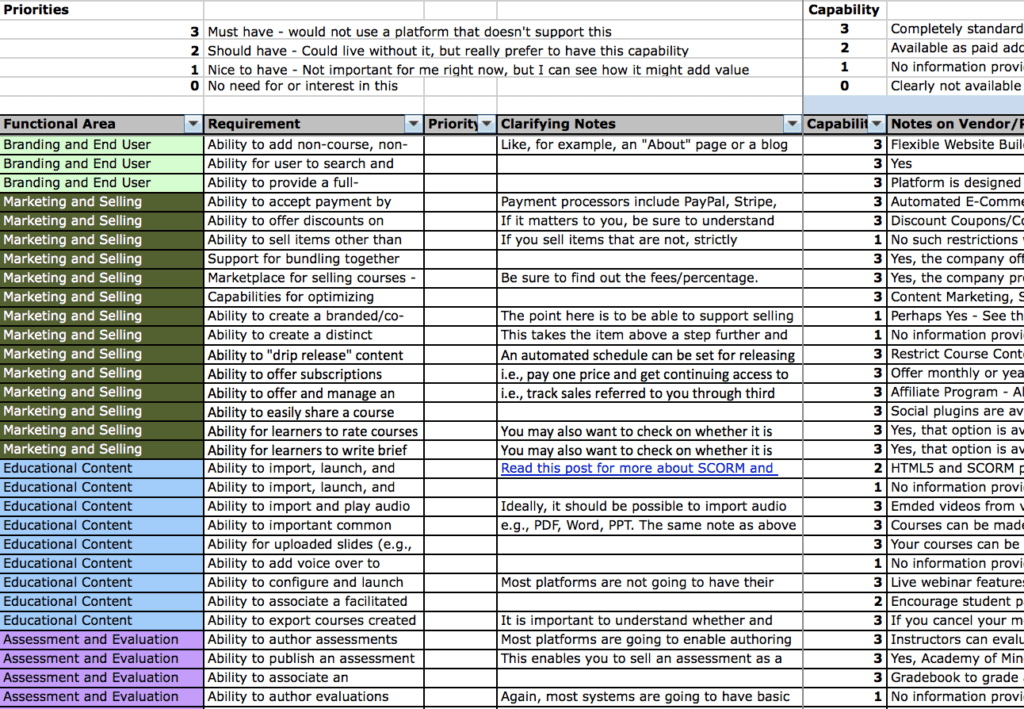
Let’s face it – deciding on a the best platform to sell your online courses can seem daunting. Even with great platforms like Thinkific available, it’s hard to get rid of that nagging question that dedicated course entrepreneurs always have in the back of their minds: “Is this really the best online course platform for me?”
I’ve spent the past 20 years building platforms, selling platforms, implementing platforms, and most recently, helping hundreds of individuals and organizations back the right platform for their course business. Here are five key lessons I’ve learned when it comes to making the right choice:
1. Strategy First
Don’t make the online course platform your first step.
When you decide to create online courses, it’s very tempting to fire up Google and start searching for all of the options for taking your content online. There are at least two big reasons not to do that.
The first is that you will likely find yourself suffering from “choice overload” very quickly. There are many platforms out there – hundreds by some counts – and the number seems to be growing daily. That’s great on a certain level. It means there is bound to be a platform that fits your needs.
The problem is that your average aspiring course entrepreneur has a very hard time telling one platform from the next. If you haven’t ever really thought about course platforms before, much less used one, then you don’t know the “mental shortcuts” that will help you whittle down the choices.
What usually happens next is that “paralysis by analysis” sets in. In other words, you do nothing. You procrastinate. Not just on picking a platform, but on your whole course project.
That’s one big reason not to make the platform your first step.
The second is that you can get so caught up in all the cools things that different platforms can do that you let the tail start wagging the dog. That is, instead of letting your business strategy and your learning strategy drive your course platform choice, you pick a platform purely because of all the seemingly cool bells and whistles. Then you try to shoehorn it into your business and learning strategy. Sometimes that works. Very often it doesn’t.
In case it is not already obvious, getting very clear about your business strategy and your learning strategy should be your first step in picking a platform. You need to know where you want to go as a business. You need to know what experience you need to create for your learners in order to deliver the positive outcomes you plan to promise.
Only once you know those things should you go looking for a platform.
2. Compare Apples to Apples
This point builds directly from my first point. Again and again I have people write into me and say they are considering, for example, Udemy and Thinkific as their platform choices. I tell them – as tactfully as I can, of course – you don’t know what you are doing.
Why?
These are fundamentally different platforms and fundamentally different choices. Apples and oranges, in my opinion.
Yes, they will both deliver online courses.
Yes, they may both support your learning strategy.
But from a business strategy (and tactics) standpoint, they are really different. You will have much more control over your content, your data, your pricing, and numerous aspects of your business if you go with a platform like Thinkific or Teachable. Of course, with all that control, you are probably going to have to step up a bit more in making business decisions and you won’t have a pre-made marketplace to list your courses in like you would with Udemy.
Very different choices.
The fact is, if you really need a marketplace, then you really need a marketplace. If you really need a WordPress plugin, then you really need a WordPress plugin.
But make those decisions early in the process – certainly well before you come down to a final decision – so that you are actually comparing platforms that are in the same category. (I have, by the way, broken platforms down in to categories in this post.)
3. Nail Your Requirements
Once you are clear about your strategy and about the type of platform you are looking for, spend some time thinking through and documenting your detailed requirements – i.e., the features you need your course platform to have – before you go shopping.
Again, you don’t want the tail to wag the dog. The features you need should be driven by your strategy, not by whatever looks cool when you go shopping.
I know this can be a bit tedious, especially if you aren’t a detail-oriented person, but it really helps with making sure you stay focused as you vet different platforms and don’t get distracted by a bunch of bells and whistles.
To help with that process, consider grabbing my free online course platform guide.
Part of what I include with this is an Excel sheet that lists out and organizes most of the major features you will want to consider in a course platform. This makes it much easier to figure out the features than matter to you and set priorities.

You may, of course, change your priorities some – and even add in some new features – once you get a close look at what is actually available out there, but by using the worksheet, you’ll have a solid start that is grounded in what works best for you, your business, and your learners.
4. Be Realistic
One of the most common topics I hear about from Learning Revolution readers is marketing. I’m not even sure how many have written in at this point to say they want a platform that will “do the marketing for me.”
Sorry, that isn’t going to happen.
Yes, good course platforms will definitely provide good tools for creating sales pages, e-mailing your users, managing affiliates, and all sorts of other marketing activities. And the best online course platforms will give you some support and education on how to market your courses effectively. But neither the platform nor the company is going to market for you.
And, to be clear, that is as true of the “marketplace” platforms as it is of other options. To stand out and actually convert visitors to those platforms, you have to do marketing of your own – starting with building an audience for your online courses. Yes, there is marketing you can offload, but there will always be parts of marketing you can’t. Marketing just goes with being in business.
The bottom line is that online course platforms are built for delivering online courses and managing your learners. There are many other areas of running a successful online course business in which they can provide some helpful tools, but there is no magic platform that is going to get all your courses online for you, market them successfully, and send you a check each month while you sit on the beach drinking Mai Tai’s.
(Okay, I suppose artificial intelligence could change all of the above some day. If it does, I’ll happily take it all back!)
5. Don’t Over Think It
I know: easier said than done. But really, as great as some of the platforms can be, the value of your online course business is not in your platform. It’s in your content. It’s in your relationship with your learners. Most fundamentally, it’s in you.
Yes, changing platforms down the road – if it comes to that – can be a pain, but trying to guess the future is impossible.
In case it is not already obvious, there is no single, one-size-fits all best online course platform. There is only the best online course platform for your specific needs at this specific time. Your course platform is not your destiny.
There’s a good chance that down the road you will need to retire or significantly revamp your courses anyway, and that will be a good time to review, reflect, and determine if a different platform makes sense.
In the meantime, find something that fits your needs well now (again, starting with your business and learning strategy), and get going.
See also
**
A version of this post originally appeared on the Thinkific blog.
Table of Contents
Related Posts
LearnDash vs LifterLMS | Which Is The Best WordPress LMS (2023)
Podia vs Thinkific (2024) | What’s The Best Online Learning Platform
Teachable vs Udemy | Which Online Course Platform Is Right For You